|
Well, It's been about a month since I began construction of The Floating Bear, a ten foot long kite-powered sailboat designed to solo circumnavigate the globe. Building has been fast and furious, but still maintaining an attention to detail and strength. The Bear is nearing the end of the construction process. As of today the final coat of paint is drying, and all that remains is fitting out the interior with electronics, instruments, ballast tanks and food storage bins.
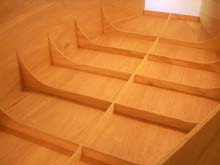 |
interior shot showing the ribs and bottom panel before epoxy.
click images to enlarge |
| sides and decking going on |
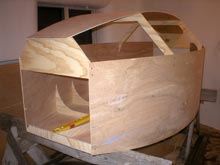 |
The design is quite simple, borrowing heavily from Phil Bolger and the like. A flat bottom boat with about eight inches of rocker, plumb sides and a four foot beam. The deck is built high and flared to allow quick self-righting after a capsize. Lateral resistance is provided by a leeboard. Construction has been of 1/4" and 1/2" plywood with several layers of Eglass and epoxy. Total empty hull weight is 140 pounds. Total displacement all up and ready to cruise will be in the six to eight hundred pound range, depending on the length of the passage. Food and water supply will be an integral part of the ballast system, to be replaced by salt water as they are consumed.
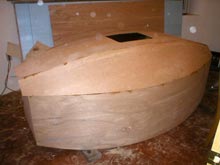 |
bulkheads and decking in place |
| foam ends in place and faired with phenolic microballoons and epoxy |
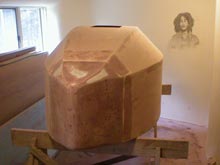 |
Huh? You must be wondering how an oceangoing boat can be built so small and light. Well, the secret is in the power supply. This boat does not have a conventional sail rig: mast, boom, etc. It relies on kites flown from heavy line to provide the energy to move the boat through the water. The kites vary from simple single line parafoils for broad reaching and running, to complex and efficient four line ram air kites for beam and close reaching. They will be flown from a point on the leeward rail as close to the water line as possible. This virtually eliminates heeling and the need for a large and heavy keel to provide righting force. Therefore the boat can be built to be much lighter than a conventional sailboat, without all the necessary reinforcement to provide attachment points for a keel and mast.
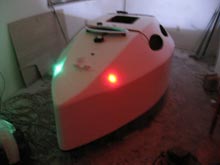 |
LED running lights installed, boat painted with 5 coats of System Three WPU |
| Launch Day! At least, launch it out the window day. |
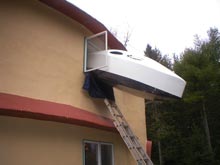 |
Also, the boat is to be steered, not with a rudder, but by moving the kite attachment point relative to the center of lateral resistance (leeboard). This eliminates the sometimes unwanted lift created by the rudder at higher speeds.
All this is mostly theory, as the full size boat has yet to hit the water, although my predictions are based on extensive testing of the half-scale model. As the boat is nearly complete, I will soon be heading to Florida and the (relatively) warm waters of the Gulf of Mexico/Florida Bay for trials and adjustments. I'll keep you updated as to how things are progressing.
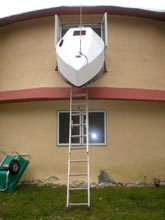 |
Just BARELY makes it out the window! |
| And safely on the ground. |
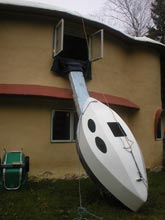 |
Sincerely,
Steve Rinker,
Hampden Maine
|

